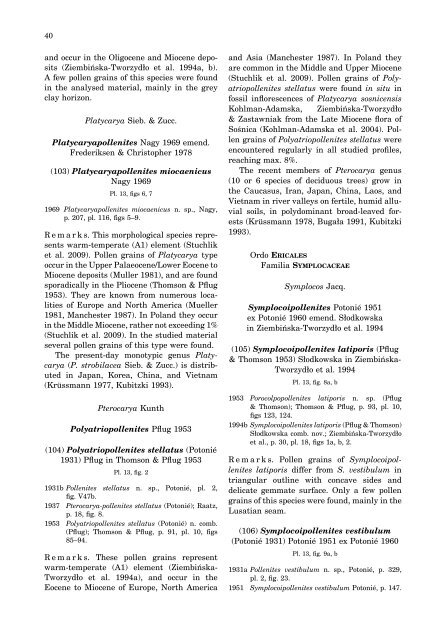Middle Miocene palynoflora of the Legnica lignite deposit complex ...
Middle Miocene palynoflora of the Legnica lignite deposit complex ...
Middle Miocene palynoflora of the Legnica lignite deposit complex ...
You also want an ePaper? Increase the reach of your titles
YUMPU automatically turns print PDFs into web optimized ePapers that Google loves.
40<br />
and occur in <strong>the</strong> Oligocene and <strong>Miocene</strong> <strong>deposit</strong>s<br />
(Ziembińska-Tworzydło et al. 1994a, b).<br />
A few pollen grains <strong>of</strong> this species were found<br />
in <strong>the</strong> analysed material, mainly in <strong>the</strong> grey<br />
clay horizon.<br />
Platycarya Sieb. & Zucc.<br />
Platycaryapollenites Nagy 1969 emend.<br />
Frederiksen & Christopher 1978<br />
(103) Platycaryapollenites miocaenicus<br />
Nagy 1969<br />
Pl. 13, fi gs 6, 7<br />
1969 Platycaryapollenites miocaenicus n. sp., Nagy,<br />
p. 207, pl. 116, fi gs 5–9.<br />
R e m a r k s. This morphological species represents<br />
warm-temperate (A1) element (Stuchlik<br />
et al. 2009). Pollen grains <strong>of</strong> Platycarya type<br />
occur in <strong>the</strong> Upper Palaeocene/Lower Eocene to<br />
<strong>Miocene</strong> <strong>deposit</strong>s (Muller 1981), and are found<br />
sporadically in <strong>the</strong> Pliocene (Thomson & Pfl ug<br />
1953). They are known from numerous localities<br />
<strong>of</strong> Europe and North America (Mueller<br />
1981, Manchester 1987). In Poland <strong>the</strong>y occur<br />
in <strong>the</strong> <strong>Middle</strong> <strong>Miocene</strong>, ra<strong>the</strong>r not exceeding 1%<br />
(Stuchlik et al. 2009). In <strong>the</strong> studied material<br />
several pollen grains <strong>of</strong> this type were found.<br />
The present-day monotypic genus Platycarya<br />
(P. strobilacea Sieb. & Zucc.) is distributed<br />
in Japan, Korea, China, and Vietnam<br />
(Krüssmann 1977, Kubitzki 1993).<br />
Pterocarya Kunth<br />
Polyatriopollenites Pfl ug 1953<br />
(104) Polyatriopollenites stellatus (Potonié<br />
1931) Pfl ug in Thomson & Pfl ug 1953<br />
Pl. 13, fi g. 2<br />
1931b Pollenites stellatus n. sp., Potonié, pl. 2,<br />
fi g. V47b.<br />
1937 Pterocarya-pollenites stellatus (Potonié); Raatz,<br />
p. 18, fi g. 8.<br />
1953 Polyatriopollenites stellatus (Potonié) n. comb.<br />
(Pfl ug); Thomson & Pfl ug, p. 91, pl. 10, fi gs<br />
85–94.<br />
R e m a r k s. These pollen grains represent<br />
warm-temperate (A1) element (Ziembińska-<br />
Tworzydło et al. 1994a), and occur in <strong>the</strong><br />
Eocene to <strong>Miocene</strong> <strong>of</strong> Europe, North America<br />
and Asia (Manchester 1987). In Poland <strong>the</strong>y<br />
are common in <strong>the</strong> <strong>Middle</strong> and Upper <strong>Miocene</strong><br />
(Stuchlik et al. 2009). Pollen grains <strong>of</strong> Polyatriopollenites<br />
stellatus were found in situ in<br />
fossil infl orescences <strong>of</strong> Platycarya sosnicensis<br />
Kohlman-Adamska, Ziembińska-Tworzydło<br />
& Zastawniak from <strong>the</strong> Late <strong>Miocene</strong> fl ora <strong>of</strong><br />
Sośnica (Kohlman-Adamska et al. 2004). Pollen<br />
grains <strong>of</strong> Polyatriopollenites stellatus were<br />
encountered regularly in all studied pr<strong>of</strong>i les,<br />
reaching max. 8%.<br />
The recent members <strong>of</strong> Pterocarya genus<br />
(10 or 6 species <strong>of</strong> deciduous trees) grow in<br />
<strong>the</strong> Caucasus, Iran, Japan, China, Laos, and<br />
Vietnam in river valleys on fertile, humid alluvial<br />
soils, in polydominant broad-leaved forests<br />
(Krüssmann 1978, Bugała 1991, Kubitzki<br />
1993).<br />
Ordo ERICALES<br />
Familia SYMPLOCACEAE<br />
Symplocos Jacq.<br />
Symplocoipollenites Potonié 1951<br />
ex Potonié 1960 emend. Słodkowska<br />
in Ziembińska-Tworzydło et al. 1994<br />
(105) Symplocoipollenites latiporis (Pfl ug<br />
& Thomson 1953) Słodkowska in Ziembińska-<br />
Tworzydło et al. 1994<br />
Pl. 13, fi g. 8a, b<br />
1953 Porocolpopollenites latiporis n. sp. (Pfl ug<br />
& Thomson); Thomson & Pfl ug, p. 93, pl. 10,<br />
fi gs 123, 124.<br />
1994b Symplocoipollenites latiporis (Pfl ug & Thomson)<br />
Słodkowska comb. nov.; Ziembińska-Tworzydło<br />
et al., p. 30, pl. 18, fi gs 1a, b, 2.<br />
R e m a r k s. Pollen grains <strong>of</strong> Symplocoipollenites<br />
latiporis differ from S. vestibulum in<br />
triangular outline with concave sides and<br />
delicate gemmate surface. Only a few pollen<br />
grains <strong>of</strong> this species were found, mainly in <strong>the</strong><br />
Lusatian seam.<br />
(106) Symplocoipollenites vestibulum<br />
(Potonié 1931) Potonié 1951 ex Potonié 1960<br />
Pl. 13, fi g. 9a, b<br />
1931a Pollenites vestibulum n. sp., Potonié, p. 329,<br />
pl. 2, fi g. 23.<br />
1951 Symplocoipollenites vestibulum Potonié, p. 147.

















